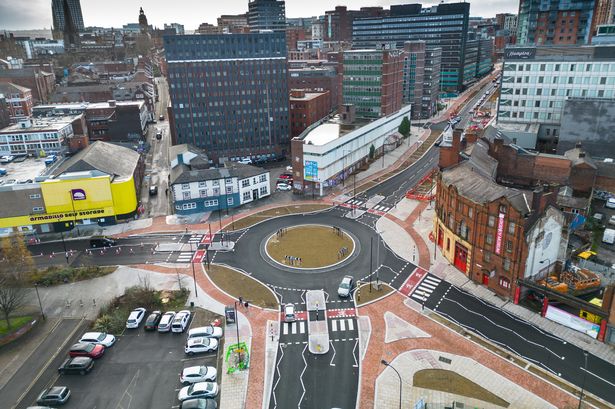The newly opened £18 million roundabout, significantly delayed and exceeding its initial completion date by over a year, has immediately sparked controversy due to its complex and potentially confusing give-way regulations. Designed to improve traffic flow and reduce congestion in a heavily trafficked area, the roundabout’s intricate layout, featuring multiple lanes and unconventional entry and exit points, has instead generated concern amongst motorists. The public’s bewilderment stems from the unclear hierarchy of right-of-way, with some drivers uncertain about when to yield and when to proceed, creating a potential breeding ground for accidents and near misses. This initial confusion has raised questions about the efficacy of the roundabout’s design and the adequacy of pre-opening driver education initiatives. Many argue that the design prioritizes aesthetics over functionality, leading to an unnecessarily complicated system that could have been avoided with a more conventional approach.
The prolonged construction period, coupled with substantial cost overruns, adds another layer of contention to the roundabout’s problematic launch. Originally slated for completion over a year ago, the project faced numerous delays attributed to various factors, including unforeseen ground conditions, supply chain disruptions, and contractor-related issues. These delays not only inconvenienced commuters and local businesses during the extended construction phase but also contributed to mounting frustration with the project’s ultimate outcome. The final cost, a staggering £18 million, significantly exceeded initial budget projections, further fueling public criticism and raising questions about the project’s overall value for money. Many are now questioning whether the benefits of the new roundabout, in terms of improved traffic flow and reduced congestion, will ultimately justify the significant financial investment and prolonged disruption.
Adding to the public’s frustration is the perceived lack of clear and accessible information regarding the roundabout’s give-way rules. While some signage exists, many drivers report finding it inadequate and confusing, failing to provide sufficient guidance on navigating the complex lane system and determining right-of-way. The absence of a comprehensive public awareness campaign prior to the roundabout’s opening has exacerbated the confusion, leaving many motorists feeling unprepared and apprehensive about using the new junction. Calls are now mounting for clearer signage, online resources, and potentially even driver education programs to help motorists understand the roundabout’s intricacies and ensure safe and efficient navigation. This lack of proactive communication and driver education is seen as a major contributing factor to the current state of confusion and anxiety surrounding the roundabout.
The situation is further complicated by the roundabout’s location in a busy area, serving as a key intersection for multiple major roads and handling a high volume of traffic daily. This high traffic volume amplifies the risks associated with the confusing give-way rules, increasing the likelihood of accidents and further congestion. The potential for confusion and hesitancy at the roundabout, particularly during peak hours, could exacerbate existing traffic issues, negating the intended benefits of the project. Critics argue that the roundabout’s design failed to adequately consider the specific traffic demands of its location, leading to a solution that may be ill-suited to its intended purpose. The impact on emergency services navigating the complex junction also raises concerns, potentially delaying response times in critical situations.
The responsibility for the roundabout’s problematic launch and the confusion surrounding its give-way rules is a subject of ongoing debate. Some point fingers at the design engineers, arguing that the roundabout’s complexity is inherently flawed and unnecessarily convoluted. Others criticize the local authorities for failing to adequately communicate the roundabout’s rules to the public and provide sufficient driver education resources. The contractors involved in the project have also faced scrutiny for the lengthy delays and cost overruns, adding to the overall negative perception of the project. Determining accountability and implementing corrective measures will be crucial to addressing the current issues and restoring public confidence in the project. A thorough review of the design, signage, and public communication strategies is essential to ensure the roundabout’s long-term viability and effectiveness.
Moving forward, several steps are needed to address the confusion and improve the functionality of the £18 million roundabout. Firstly, a comprehensive review of the existing signage is necessary, with a focus on clarity, visibility, and comprehensiveness. Secondly, a robust public awareness campaign should be launched, utilizing various channels such as online resources, social media, and traditional media outlets, to educate drivers about the roundabout’s rules and navigation. Consideration should be given to providing temporary traffic management solutions, such as traffic marshals or adjusted lane markings, to assist drivers during the initial transition period. Finally, a thorough investigation into the project’s delays and cost overruns is warranted to identify areas for improvement in future infrastructure projects. By taking these steps, local authorities can address the current issues, mitigate future risks, and ensure that the roundabout ultimately serves its intended purpose of improving traffic flow and reducing congestion. Ultimately, the success of the roundabout will depend on effective communication, driver education, and a commitment to addressing the legitimate concerns raised by the public.














